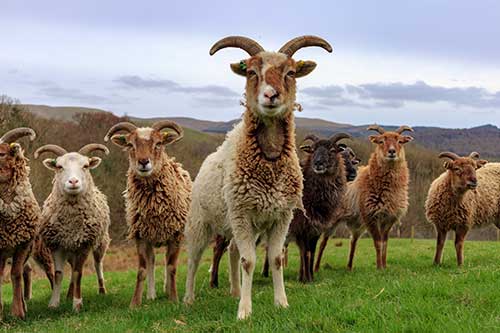Conservation and Management of Natural Resources
Intro
Conservation and Management of Natural Resources
The Millennium Ecosystem Assessment (2001-2005) was the first of many reviews to highlight the importance of ecosystem functioning for human well-being. Grasslands and moorlands provide a range of public goods beyond food production, and there is growing public and political awareness of the need to reinforce and reward delivery of such resources and functions. These include water management (e.g. provision of drinking water and flood mitigation), carbon management (e.g. soil carbon sequestration and storage), landscape and heritage management, and biodiversity. Our research explores the impact of land use and land use change on such parameters, quantifying interactions between different elements of the system to provide a sound evidence base for the development of innovative management scenarios.
Our aim is to deepen our knowledge of how management of grassland systems impacts upon related natural capital and ecosystem service provision.
Approach
Approach
We work across spatial (plots to landscapes) and temporal (days to decades) scales to understand and exploit soil/plant/animal interactions along a continuum from forage crops and short-term leys to permanent pasture and semi-natural rough grazing and heathlands. Over the past sixty years the extent and condition of native vegetation communities, which account for over a third of UK agricultural land, have declined due to inappropriate management. Through understanding and exploiting species and breed differences in grazing behaviour we have developed new approaches to managing grazed ecosystems. As well as shaping government policy and underpinning options within agri-environment schemes, the findings have influenced the work of leading conservation bodies. Complementary projects are designing and testing new drone-based technologies for tracking the impacts of livestock across large-scale enclosures to enable strategies for manipulating their spatial distribution to be developed and refined. Where undergrazing rather than overgrazing has become a threat to habitats we have worked with national and international collaborators and stakeholders to develop new processing technologies to exploit the bioenergy and biorenewable products potential of biomass generated by conservation management.
Our work with new pastures is combining the latest plant breeding advances [link to plant breeding sub-section] with ecological theories of niche complementarity and facilitation to improve the multi-functionality of grassland in addition to providing high quality forage for livestock. By understanding the underlying mechanisms for improved nutrient use efficiency under different forage systems, we are gaining deeper insight into the wider impacts of forage diversity within grassland-based systems.
Current Projects
Main Projects
- Developing the Circular Carbon Economy in NW Europe based on bio-waste (3CHub) (Co-I, INTERREG; €3.0M; 2019-2023; www.nweurope.eu/projects/project-search/three-c-creating-and-sustaining-charcoal-value-chains-to-promote-a-circular-carbon-economy-in-nwe-europe/)
- The Ecology Within: The impact of gut ecosystem dynamics on host fitness in the wild (NERC large grant; £3M; 2019-2023; soaysheep.biology.ed.ac.uk/ecologywithin)
- MISCOMAR+: Miscanthus for contaminated and marginal lands PLUS (FACCE; €1.2 M; 2020-2023; https://projects.au.dk/faccesurplus/research-projects-3rd-call/miscomar/)
- Sustainable livestock systems for the Andes (GCRF; £20K; 2020-2021; link to Universidad Nacional Agraria La Molina, Peru www.lamolina.edu.pe)

Soay sheep, native to the St Kilda archipelago in the Atlantic, and used in grazing studies (photo - J. Moorby)
Outputs
Outputs
- ‘Excellent’ impact on best practice and policy frameworks in relation to grazing in the uplands https://impact.ref.ac.uk/casestudies/CaseStudy.aspx?Id=42083
- Supporting evidence for the inclusion of semi-wild ponies in the wording of Agriculture Bill 2020.
- Rush biomass designation as non-waste.
- Development of a range of low-cost unmanned aerial vehicle (drone)-based technologies for mapping large enclosures and tracking grazers
Research Capabilities
Research Capabilities
The Pwllpeiran Upland Research Platform is a centre for the study of upland farmed ecosystems. Related resources at the Centre include:
- 650 ha of land between 250 m a.s.l. to 590 m a.s.l.
- Range of vegetation types from reseeded improved swards to mountain pasture
- The Brignant long-term plots
- Four full weather stations plus network of microclimate sensors
- Up to 1 Gbps broadband
